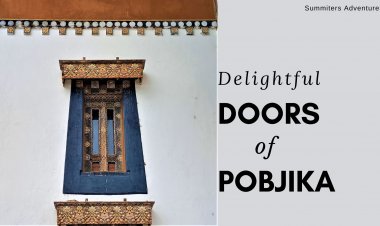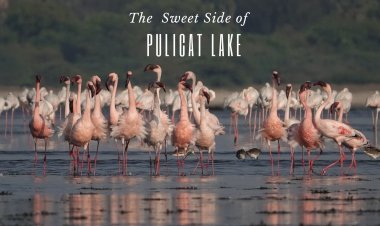Markhor - A Wandering Monarch of Mountain Cliffs
Among the goats, a species which has made cliffs of mountains as their home. These high altitude species is a born mountaineer and is regarded as the largest among mountain goat on the planet. It is considered as a creature of myth, a victim of war, and a testament to resilience. Markhors habitat is sandwiched, between 2 nations. A recent visit to its habitat in Indian counterpart reveals that there were two viable populations of the species in Jammu and Kashmir. Their survival depends on harmony between two nations. The Question is War or Peace ?. For their survival. Its high time to decide !.Before we lose the Monarch forever.
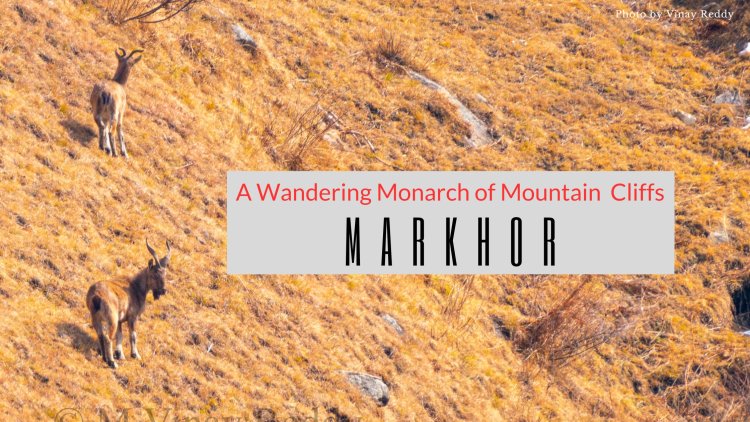
In the recent past, the bordering district of baramulla in Jammu & Kashmir was in news.It was not of any insurgency or millitant acitvity. But Surprisingly, it was of spotting a rare species of injured high altitude mountain goat - known as MARKHOR and later rescued in Kashmir.
It is said to be the National Animal of Pakistan.
( The word 'markhor' comes from Pashto and Classical Persian and means 'snake eater.' It is said that the Markhor kills and eats snakes. After this, while ruminating, a foam-like substance comes out of its mouth. After the foam dries up, local use this foam to make anti-dote for snake poison in case of snake bite. It can be found between an altitude of 2,000 to 11,800 feet )
It drew my attention instantly. Having seen the Chukur Patridge, the National bird of Pakistan in my Himalayan sojourns of Spiti and Uttarakhand.Though i was aware of Markhor, I never thought of going upto to LOC for this elusive mammal. !
Though the initial plans of visiting Kashmir during chillai Kalan was confined to Dachigam National Park, Budgam, Yousmarg, Chadoora, Wular wet lands and Pampore for photography.However during my stay in Srinagar, the last 2 additional days came as boon and motivated us to visit its Markhor habitat in Lachipora Wildlife Santuary.
Overall both,making a decision and arranging officals permits
was not a easy affair !.
The prime habitat for the Kashmiri markhor is Kazinag Wildlife Sanctuary, the upper part of Lachipora spread over an area of 160 sq km. Located about 70 km from Srinagar and close to the LOC in Baramulla, Kazinag has a rugged landscape characterised by rocky outcrops, steep slopes, and flora that include pine, deodar, fir, birch, and juniper trees. In summer, the region has temperate and alpine grasslands that provide sufficient food for the markhor, but winter is challenge for these species !
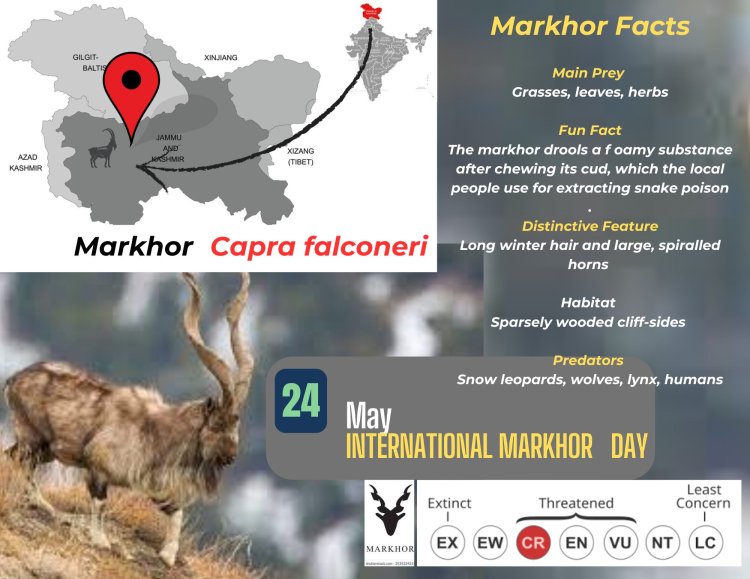
However during our short visit we were able to sight the species in its natural habitat.It was literally difficult to photograh them as it was out of reach for a 600 telephoto lens.The region is home to Black & Brown bears, Snow leopards, Ghoral, Golden eagle, Bearded vulture, Kasturi and many winter birds endemic to region.
Monarch of Mountains
Our guide lateef, mentioned that he has been observing them since decades in all seasons from dawn to dusk, and nothing is in comparison with them.
Markhors are skilled mountaineers, capable of scaling and descending the steepest of cliffs with ease. Their sturdy body, strong hoofs, and powerful legs are gods gift for this habitat, and they make the most of it. “I have seen markhor running along vertical cliffs that are 90 degrees from the ground,” Lateef adds “It is incredible to see a 100 to 120 - kilo animal jump along cliffs in a single leap. They can easily clear 100 feet in a single jump, and they are well camouflaged in grass and cliffs.They are really ' Badshah ' of the mountains.
A day with Elusive species
We were a valley circular in shape, surrounded by cliffs. As the sun lit the grassy slopes.Our guide spotted, a pair of ghorals and Markhors on slopes.Markhors are mixed feeders. In the summer, when forage is abundant, they are varacious eaters, feed on herbs, and ground-cover plants predominantly.
“In winter, they descend to lower altitudes eat branches of shrubs, dry up grass, and coniferous leaves,” says Lateef. They dwell in rocky outcrops and caves where they can warm themselves.” With the help of powerful binoculars we could even see them licking rocks which are rich in salt and other nutrients by licking mineral-rich rocks.
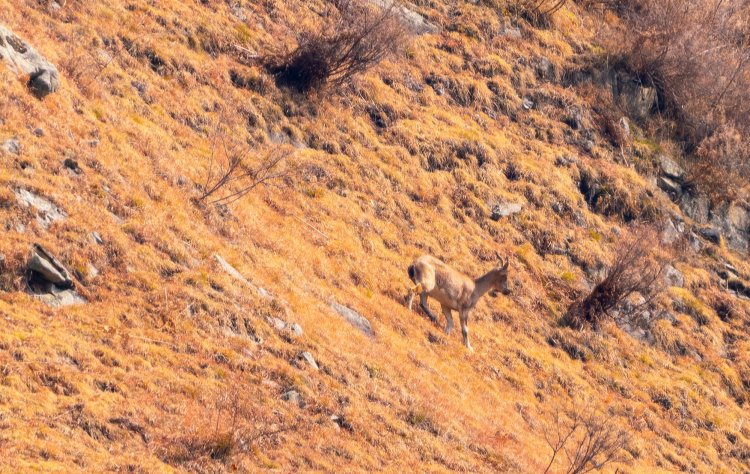 Male and female Markhors look significantly different. Male markhors (Above pic) have horns which are strong and grow up to 150 cm in length, and a discernible beard clinging under their chins. They are also differently coloured than females. “Markhors have different natural coats for protection in summer as well and winter,” explains Lateef.
Male and female Markhors look significantly different. Male markhors (Above pic) have horns which are strong and grow up to 150 cm in length, and a discernible beard clinging under their chins. They are also differently coloured than females. “Markhors have different natural coats for protection in summer as well and winter,” explains Lateef.
Breeding Season
The mating season for Markhors is from mid-December to mid-January, and birthing occurs between mid-May and mid-June when food is plentiful. During the courtship period, males fight each other by locking horns to establish dominant status. According to Lateef, while the dominant male will mate with 10 -15 females, unlike other species he has no responsibility and caring to do with rearing of the young.
A Bearded Vulture Soaring high in the Sky
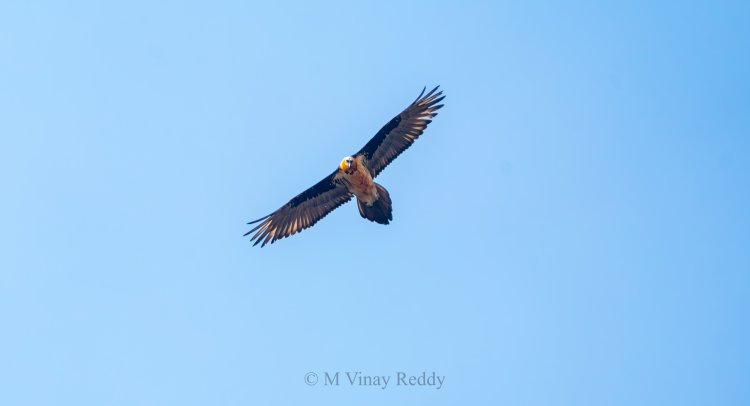 It is a challenge for female to protect young ones from predators - Leopards, Bearded Vulture, Yellow-throated marten, and golden eagle are their threats.” It is nice to watch fawn with the mother for the first year of their lives, during which they learn to forage and traverse the rocky landscape.
It is a challenge for female to protect young ones from predators - Leopards, Bearded Vulture, Yellow-throated marten, and golden eagle are their threats.” It is nice to watch fawn with the mother for the first year of their lives, during which they learn to forage and traverse the rocky landscape.
Man & Markhor Survival Conflict
Lateefs, love and affection for Markhor is our of words !.Everyday he climbs the hills and cliffs to look for goats.He says that village is his world,and about 30 -40 families stay here.He is dependant on guiding and has meagre income to support his family.
He says ' Ccommunities within the markhor’s territory have forest-dependant lifestyles. For example, they gather wood for fuel to cook and keep warm and gather herbs for sale. As human need is growing, the markhor’s range is depleting, due to human intervention.
I can see tears in his eyes, when he says I dont have alternative sources of income for me and other residents other than porterage. He says proudly, however I have piece of land, I work for WTI - Wildlife Trust of India and i am paid a meagre salary. “ I am alone and also creating awareness about the Markhor’s conservation ,” says Lateef.
Without second thought one can say Lateef as selfless indiviudal and is a Good Samaritan.!
During observation when i mentioned that " I was observing a markhor, but actually, he said that it was observing me. He advised us " Dont move ". They can spot danger from miles away. I have observed the way they hit the ground with their hooves to sound an alarm and how quickly they can disappear into the landscape.
Though it is known as Kashmir Markhor, resident to India, markhors were considered extinct until a state-wide survey in 2004 revealed that there were two viable populations of the species in Jammu and Kashmir, Limber, Naganari, Lachipora and Hirpora.The final count being only 300 left in the wild !
Both regions are now classified as national parks, but these are areas with inhospitable landscapes and high levels of military activity due to their proximity to the Line of Control.








